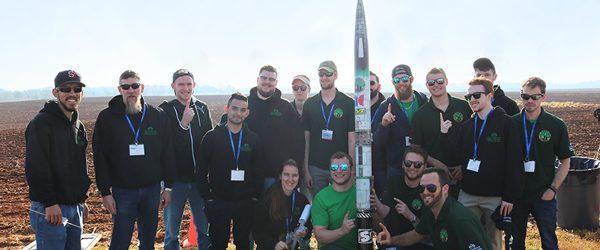49er Rocketry Team scores second in NASA contest

The results are in, and UNC Charlotte’s 49er Rocketry Team achieved major success at this year’s NASA Student Launch Competition.
The UNC Charlotte team finished second overall at the competition, besting N.C. State University, University of Akron and Oregon State University. Forty-five teams from 20 states took part in the Student Launch Competition, held at Marshall Space Flight Center in Huntsville, Alabama, in April. Vanderbilt Aerospace Design Lab from Vanderbilt University won top honors.
For the 2018-19 competition, teams had to design, build and test a rocket and payload while meeting multiple documentation and review criteria. Teams had to predict the altitude their rocket would fly to, and deploy either a rover or flying drone payload.
UNC Charlotte was the first university to launch. The 49er rocket’s altitude was within 130 feet of predicted apogee. The payload section recovery worked exactly as designed and the unmanned aerial vehicle (UAV or drone) successfully deployed and delivered its navigational beacon to the required target location.
In the preliminary results, the 49er team was recognized with:
- First Place – Safety Award
- First Place – Payload Design
- Second Place – Project Review
- Third Place – STEM Engagement
- Third Place – Best Looking Rocket
- Second Place – Overall
Mechanical engineering student Kyle Kalish was the project lead for the team.
“For the 2018-19 NASA Student Launch competition, the 49er Rocketry Team was tasked with designing a launch vehicle and recovery system that housed an unmanned aerial vehicle (UAV) capable of flying a simulated navigational beacon to a NASA specified Future Excursion Area, which was a brightly colored yellow tarp on the launch field,” said Kalish.
He continued, “For the launch vehicle, we were required to both design the launch vehicle and declare the altitude that we thought it would reach. We were determined to design the most aerodynamic and volumetrically efficient vehicle we could. We ran multiple computational fluid dynamic simulations on nose cone, fin and boat tail designs to determine which configuration would be the best for flight. In addition, the volumetric optimization of the launch vehicle was a main focus, as every cubic inch of wasted space in the vehicle can be considered wasted money. With this, we were able to condense all our systems into a 4.63 inch diameter airframe with an overall weight of 44.4 pounds, declaring our anticipated altitude to be 4,200 feet.
“For the payload, we went through a few design concepts, including a split airframe configuration, before choosing the UAV and deployment system. The UAV consisted of six subsystems: Object Detection and Avoidance, Ground Control, FEA Detection, Drive System, and Beacon Retention and Deployment. These systems worked in unison to allow for an autonomous take off, flight and beacon release. Mechanically, the UAV had a carbon fiber frame, folding arms and a protective shell to protect the integrity of the electrical components. The UAV deployment had six subsystems: Retention, Separation, Orientation, Stabilization, Table Lift and Arm Deployment. The systems worked to ensure that the UAV would be safely retained during flight, and be able to safely take off from the launch vehicle without any obstructions.”
The 49er Rocketry Team members were:
- Kyle Kalish
- Charles Ogino
- Kyrah Ford
- Steven Campbell
- Cameron Palkowski
- Mitchell Collins
- David Cardenas
- Dmitri Gutuleac
- Robert Cook
- Richard Bastian
- Kohl Whitlow
- William Blalock
- William Timms
- Daniel Cornett
- Alexander DeChant
- David Black
- Darrin Leer
- Jonas Bell
Read the entire story on the Lee College of Engineering website. The 49er Rocketry Club was among the fall 2018 initiatives that raised financial support via Crowdfund UNC Charlotte.